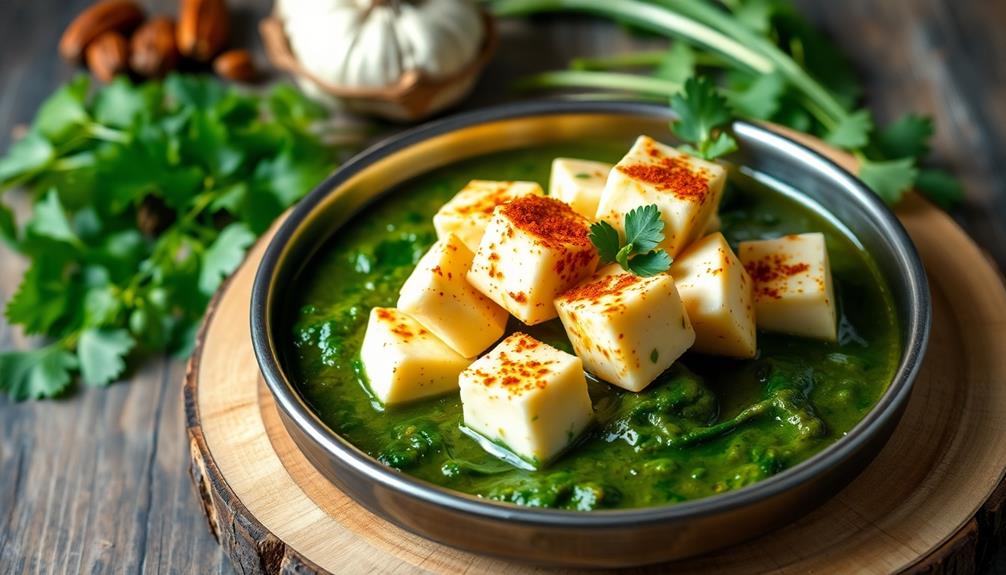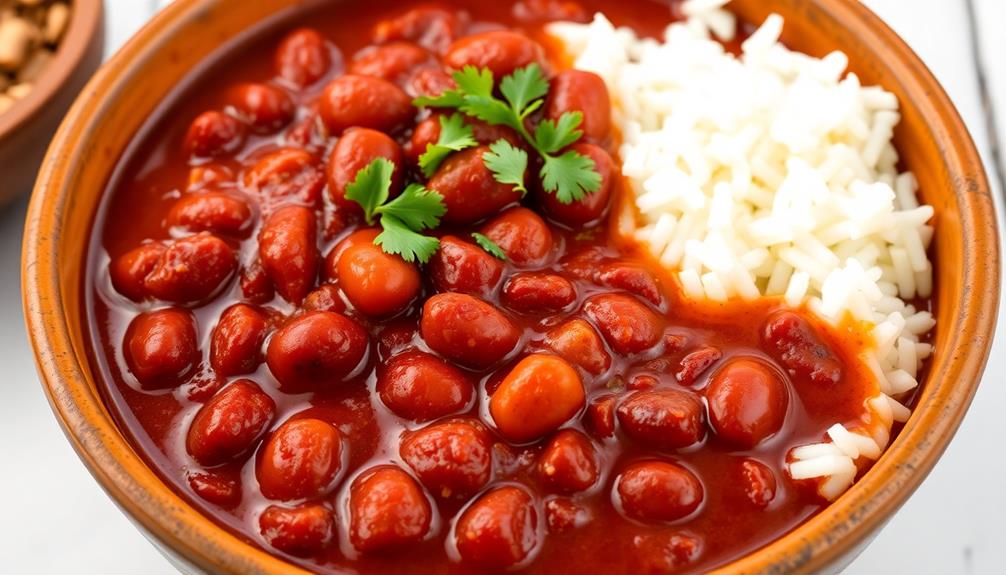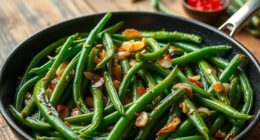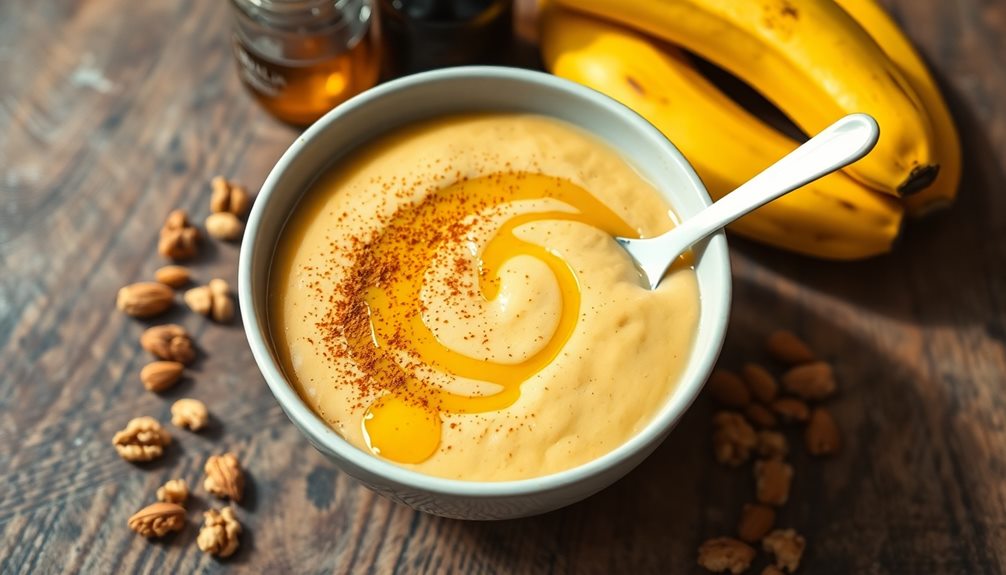You'll love diving into the vibrant world of vegetable sambar! This South Indian lentil stew combines a mouthwatering medley of fresh veggies, aromatic spices, and tangy tamarind for a comforting and flavorful dish. Sautéing the onions and garlic kicks things off, while toasting the spices unleashes their full fragrance. Then, the chopped veggies simmer to tender perfection, infusing the stew with essential nutrients and flavors. A splash of tamarind provides the perfect balance of tanginess. Garnish with cilantro, and you've got a satisfying meal that'll have your taste buds dancing. Want to learn more about the secrets behind this beloved South Indian staple? Look no further than the traditional Indian dessert of payasam, a sweet and creamy rice pudding with a hint of cardamom and saffron. The contrast of flavors and textures between the sambar and payasam creates a truly delightful dining experience. Whether you’re a fan of savory or sweet, the rich culinary traditions of South India are sure to leave you craving more.
Key Takeaways
- Vegetable sambar is a lentil-based stew that originated in the 17th century and evolved into various regional variations in South India.
- The recipe is packed with a blend of vegetables, spices, and herbs, and can be served as a main course or with rice/idli.
- Key ingredients include toor dal, onions, tomatoes, mixed vegetables, garlic, spices, tamarind paste, and oil for sautéing and seasoning.
- Cooking techniques involve sautéing, toasting spices, incorporating vegetables, simmering, and regular stirring to achieve a rich, velvety consistency.
- Vegetable sambar offers a nourishing and flavorful experience, combining spices, aromatics, and tangy elements for depth, representing the essence of South Indian cuisine.
History
Sambar, a beloved South Indian dish, has its roots deeply embedded in the region's culinary heritage. Originating in the 17th century, this versatile lentil-based stew was initially created as a way to utilize the bounty of locally-grown vegetables.
Much like the luxury tropical designs that incorporate local craftsmanship, sambar reflects the rich diversity of ingredients found in the region. Over time, the recipe has evolved, with each region and household developing their own unique variations.
What began as a humble peasant dish has now become a staple in South Indian cuisine, enjoyed by people of all backgrounds. The key to a delicious sambar lies in the perfect balance of spices, lentils, and vegetables.
Whether you're a lifelong fan or a newcomer to this flavorful dish, you're sure to appreciate the rich history and cultural significance that sambar holds. Get ready to embark on a culinary journey through the vibrant flavors of South India!
Recipe
Vegetable Sambar is a classic South Indian lentil-based stew that's packed with a flavorful blend of vegetables, spices, and herbs. This hearty and nourishing dish is a staple in many households and can be enjoyed as a main course or as an accompaniment to rice or idli.
The combination of the earthy lentils, the tangy tamarind, and the aromatic spices creates a delightful balance of flavors that will tantalize your taste buds. Cooking red lentils is simple, as they cook quickly and don't require soaking, making them an excellent choice for this dish.
Sambar is a versatile dish that can be customized to suit your preferences, allowing you to experiment with different vegetable combinations and spice levels.
Ingredients:
- 1 cup toor dal (split pigeon peas)
- 1 medium onion, diced
- 2 tomatoes, diced
- 1 cup mixed vegetables (such as carrots, cauliflower, and green beans), chopped
- 2 cloves garlic, minced
- 1 teaspoon cumin seeds
- 1 teaspoon mustard seeds
- 1 teaspoon coriander powder
- 1 teaspoon red chili powder
- 1 teaspoon turmeric powder
- 1 tablespoon tamarind paste
- Salt to taste
- 2 tablespoons oil
- Cilantro for garnish
Cooking Instructions:
In a pressure cooker, cook the toor dal with 3 cups of water until soft and mushy.
In a separate pan, heat the oil and add the mustard seeds and cumin seeds. Once they start to splutter, add the onions and sauté until translucent.
Next, add the garlic, mixed vegetables, and the spices (coriander powder, red chili powder, and turmeric powder). Sauté for a few minutes until the vegetables are slightly softened.
Add the cooked dal, diced tomatoes, tamarind paste, and salt to taste. Bring the mixture to a boil, then reduce the heat and let it simmer for 10-15 minutes, stirring occasionally, until the flavors have blended and the dish has thickened. Adjust seasoning if needed.
Serve the vegetable sambar hot, garnished with fresh cilantro. For best results, allow the flavors to meld for a few hours before serving. Enjoy this delicious and wholesome dish with steamed rice, idli, or dosa. If you’re feeling adventurous, try pairing the vegetable sambar with a side of crispy vadas for a delightful contrast in textures. For a traditional South Indian meal, serve the sambar alongside a fluffy idli and sambar dish, and finish off with a sweet and tangy mango lassi for a complete dining experience. Whether you’re a fan of spicy flavors or prefer milder dishes, the vegetable sambar is sure to be a crowd-pleaser at any gathering.
Cooking Steps
First, sauté the onions and garlic until they're nice and soft.
While you're cooking, consider enjoying a warm cup of herbal tea benefits to enhance your cooking experience.
Then, add the lentils and spices and let everything simmer together.
Finally, toss in the chopped vegetables and let them cook until they're tender.
Can't wait for you to try this tasty sambar!
Step 1. Sauté Onions and Garlic
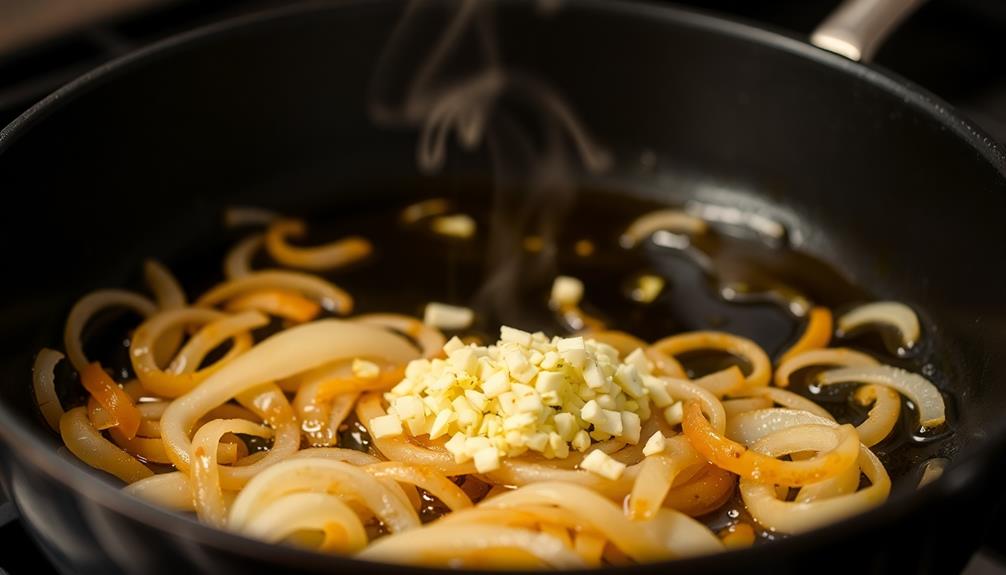
Next, sauté the onions and garlic to unlock their rich flavors. Grab a large skillet and heat it over medium-high heat.
Add a few tablespoons of oil – any neutral oil will do. Once the oil is hot, toss in the diced onions. Let them sizzle and soften for a couple of minutes, stirring occasionally.
This process is similar to how proper diet for hamsters includes fresh ingredients for optimal health.
Now, add the minced garlic. The aroma will start filling your kitchen as the garlic cooks. Sauté for another minute or so, until the onions are translucent and the garlic is fragrant.
Be careful not to let the garlic burn, as that can make it taste bitter.
Once the onions and garlic are perfectly sautéed, you're ready for the next step in your delicious vegetable sambar. Get ready to add the spices and other veggies!
Step 2. Add Lentils and Spices
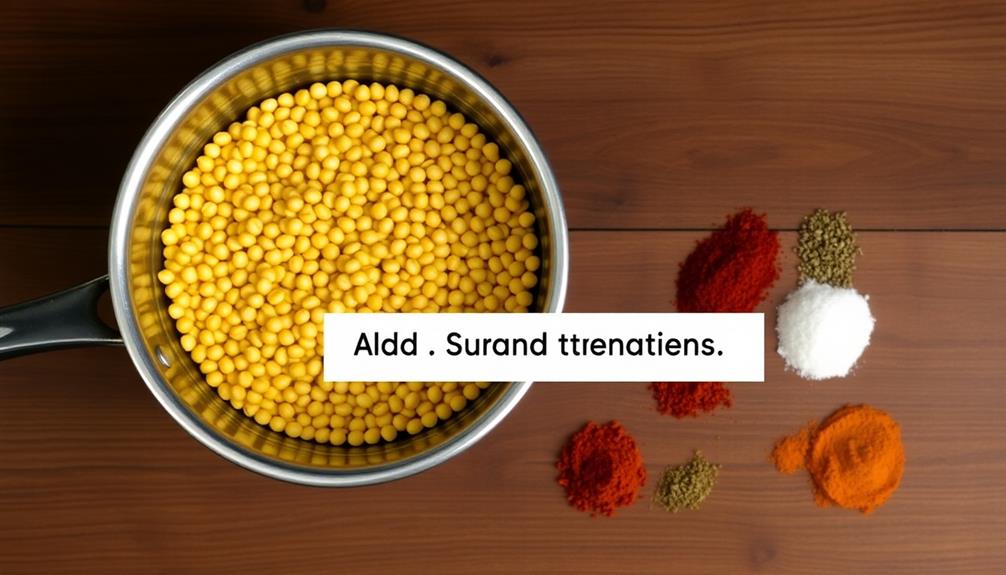
With the onions and garlic sizzling, it's time to introduce the hearty lentils and aromatic spices that will transform this dish into a flavorful sambar.
First, add the toor dal (pigeon pea lentils) and give them a stir. These little guys won't only add a lovely nutty flavor and creamy texture to the sambar, but they also provide essential nutrients like protein and fiber, promoting digestive health and weight management.
Next, it's time to spice things up! Sprinkle in the coriander powder, cumin powder, turmeric, and red chili powder. Stir everything together so the spices can toast and release their fragrance.
Don't be afraid to add a generous amount – the spices are what give sambar its signature flavor. Once the lentils are softened and the spices are fragrant, it's time to move on to the next step.
Keep stirring and simmering, and get ready for your kitchen to be filled with the most mouthwatering aroma. Your sambar is really starting to come together now!
Step 3. Add Chopped Vegetables

With the lentils and spices simmering to perfection, it's time to add the chopped vegetables that will make this sambar truly complete. Gather a variety of fresh veggies, like carrots, potatoes, okra, and peppers, which not only enhance the flavor but also provide essential nutrients.
Carefully chop them into bite-sized pieces, ensuring they're all roughly the same size for even cooking. Gently drop the prepared vegetables into the bubbling pot, stirring to incorporate them with the fragrant lentil mixture.
Juice diets may lead to nutrient deficiencies if not balanced, so including these vegetables is a great way to ensure your dish is wholesome. Let the sambar continue simmering for about 15 minutes, or until the vegetables are tender but still have a slight bite to them. This will allow the flavors to meld together beautifully.
Adjust the seasoning with a pinch more salt, if needed. Soon, your kitchen will be filled with the enticing aroma of this delicious vegetable-packed sambar. Get ready to ladle up steaming servings and enjoy this comforting, nourishing dish.
Step 4. Simmer Until Vegetables Are Tender

Simmering the sambar for about 15 minutes allows the vegetables to become tender yet maintain a slight bite, blending their flavors seamlessly with the aromatic lentil base. This gentle simmering process is reminiscent of preparing a fermented vegetable plate, where the careful balance of textures and flavors is crucial.
Gently lower the heat to medium-low and let the pot simmer, stirring occasionally. This gentle simmering process helps the vegetables soften without turning mushy. The carrots, green beans, and other veggies will become tender but still retain a pleasant, toothsome texture.
As the sambar simmers, the flavors will meld together beautifully. The lentils will thicken the broth, creating a rich, velvety consistency. Breathe in the enticing aroma of the spices as they infuse the dish.
Keep an eye on the pot, making sure the sambar doesn't boil too rapidly, which could make the vegetables overcook. Adjust the heat as needed to maintain a gentle, steady simmer. After about 15 minutes, the vegetables should be perfectly tender and ready to serve.
Step 5. Finish With Seasoning and Garnish

Having simmered the vegetables to the perfect tenderness, you can now finish the sambar by seasoning and garnishing it.
Start by adding the freshly ground spice mixture, which will infuse the dish with a warm, aromatic blend of flavors. This technique is reminiscent of the rich and flavorful Zigni, a spicy meat stew that showcases the importance of spices in African cuisine. Sprinkle it in and give the sambar a gentle stir to incorporate the spices evenly.
Next, squeeze in a bit of tangy tamarind paste or lemon juice. This will help balance the sweetness of the vegetables and create a delightful tanginess. Don't forget to taste as you go, adjusting the seasoning to your liking.
For the final touch, garnish the sambar with a handful of fresh cilantro leaves. Their vibrant green color and herbal notes will brighten up the dish and provide a lovely contrast.
You can also add a drizzle of coconut oil or a sprinkle of roasted coconut flakes for a creamy, nutty flavor. Serve the vegetable sambar hot, accompanied by steaming hot rice or fluffy idlis, and enjoy the burst of flavors in every bite!
Final Thoughts
Vegetable sambar is a nourishing and flavorful dish that brings together the best of South Indian cuisine. You've now gone through the steps to make this delightful lentil and vegetable stew – from chopping the veggies to blending the spices and simmering everything to perfection.
The final seasoning and garnish add the perfect finishing touches, making your sambar irresistible. To further enhance your meal, consider serving it alongside exotic fruit blends that add a refreshing contrast to the hearty sambar.
As you sit down to enjoy your homemade vegetable sambar, you'll be amazed at the depth of flavors. The blend of spices, aromatics, and tangy tamarind create a symphony of tastes that'll tantalize your palate.
Serving it with fluffy rice or soft idlis (rice cakes) makes for a truly satisfying meal. Don't be surprised if your family and friends request this dish time and again – it's that good! The rich flavors and comforting texture make it an ideal choice for gatherings or simple weeknight dinners. You can even incorporate this recipe into a collection of **lowfodmap holiday recipes**, ensuring everyone can enjoy a flavorful and gut-friendly meal. Whether it’s for a festive occasion or casual dinner, this dish is bound to become a go-to favorite.
With a little practice, you'll be whipping up vegetable sambar like a pro. Embrace the process, savor every bite, and enjoy this delectable taste of South India.
Frequently Asked Questions
Can I Use Different Vegetables in the Sambar?
Absolutely! You can use a variety of vegetables in your sambar. The beauty of this dish is its flexibility – feel free to experiment and incorporate your favorite veggies for a personalized flavor.
How Long Can the Sambar Be Stored in the Fridge?
You can typically store the sambar in the fridge for up to 3-4 days. However, it's best to consume it within 2-3 days for the best flavor and texture. Proper storage is key to ensuring your sambar stays fresh and delicious.
Can I Make the Sambar Vegan?
Absolutely! You can easily make the sambar vegan by replacing the dairy ingredients with plant-based alternatives. This will ensure it's free of animal products while retaining the delicious flavors you enjoy.
What Is the Best Way to Reheat the Sambar?
To reheat the sambar, you can gently warm it on the stovetop over low heat, stirring occasionally, until it's heated through. Avoid microwaving, as it can unevenly heat the dish and affect the texture. Enjoy your reheated sambar!
Can I Substitute the Tamarind With Something Else?
You can certainly substitute the tamarind in your dish with other acidic ingredients. Try using lime juice, rice vinegar, or even a combination of these to achieve a similar tangy flavor profile.




